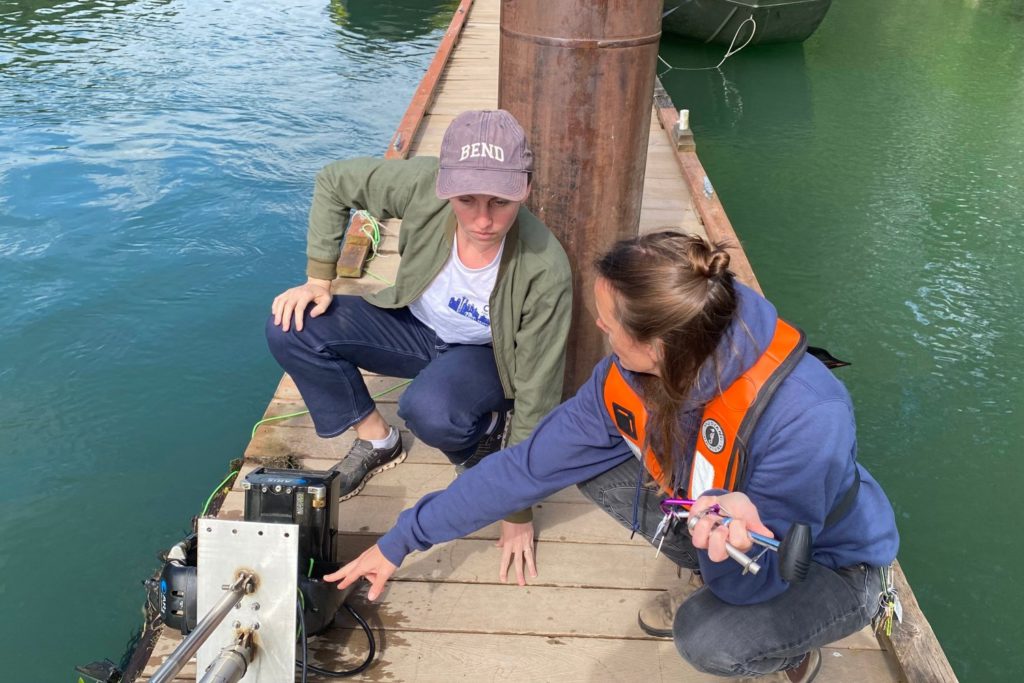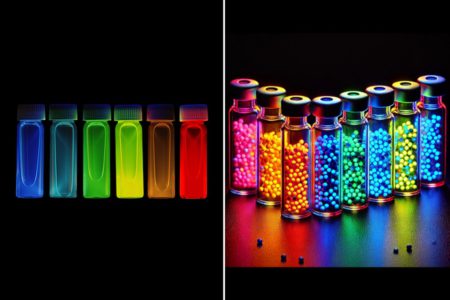Sara Beery came to MIT as an assistant professor in MIT’s Department of Electrical Engineering and Computer Science (EECS) eager to focus on ecological challenges. She has fashioned her research career around the opportunity to apply her expertise in computer vision, machine learning, and data science to tackle real-world issues in conservation and sustainability. Beery was drawn to the Institute’s commitment to “computing for the planet,” and set out to bring her methods to global-scale environmental and biodiversity monitoring.
In the Pacific Northwest, salmon have a disproportionate impact on the health of their ecosystems, and their complex reproductive needs have attracted Beery’s attention. Each year, millions of salmon embark on a migration to spawn. Their journey begins in freshwater stream beds where the eggs hatch. Young salmon fry (newly hatched salmon) make their way to the ocean, where they spend several years maturing to adulthood. As adults, the salmon return to the streams where they were born in order to spawn, ensuring the continuation of their species by depositing their eggs in the gravel of the stream beds. Both male and female salmon die shortly after supplying the river habitat with the next generation of salmon.
Throughout their migration, salmon support a wide range of organisms in the ecosystems they pass through. For example, salmon bring nutrients like carbon and nitrogen from the ocean upriver, enhancing their availability to those ecosystems. In addition, salmon are key to many predator-prey relationships: They serve as a food source for various predators, such as bears, wolves, and birds, while helping to control other populations, like insects, through predation. After they die from spawning, the decomposing salmon carcasses also replenish valuable nutrients to the surrounding ecosystem. The migration of salmon not only sustains their own species but plays a critical role in the overall health of the rivers and oceans they inhabit.
At the same time, salmon populations play an important role both economically and culturally in the region. Commercial and recreational salmon fisheries contribute significantly to the local economy. And for many Indigenous peoples in the Pacific northwest, salmon hold notable cultural value, as they have been central to their diets, traditions, and ceremonies.
Monitoring salmon migration
Increased human activity, including overfishing and hydropower development, together with habitat loss and climate change, have had a significant impact on salmon populations in the region. As a result, effective monitoring and management of salmon fisheries is important to ensure balance among competing ecological, cultural, and human interests. Accurately counting salmon during their seasonal migration to their natal river to spawn is essential in order to track threatened populations, assess the success of recovery strategies, guide fishing season regulations, and support the management of both commercial and recreational fisheries. Precise population data help decision-makers employ the best strategies to safeguard the health of the ecosystem while accommodating human needs. Monitoring salmon migration is a labor-intensive and inefficient undertaking.
Beery is currently leading a research project that aims to streamline salmon monitoring using cutting-edge computer vision methods. This project fits within Beery’s broader research interest, which focuses on the interdisciplinary space between artificial intelligence, the natural world, and sustainability. Its relevance to fisheries management made it a good fit for funding from MIT’s Abdul Latif Jameel Water and Food Systems Lab (J-WAFS). Beery’s 2023 J-WAFS seed grant was the first research funding she was awarded since joining the MIT faculty.
Historically, monitoring efforts relied on humans to manually count salmon from riverbanks using eyesight. In the past few decades, underwater sonar systems have been implemented to aid in counting the salmon. These sonar systems are essentially underwater video cameras, but they differ in that they use acoustics instead of light sensors to capture the presence of a fish. Use of this method requires people to set up a tent alongside the river to count salmon based on the output of a sonar camera that is hooked up to a laptop. While this system is an improvement to the original method of monitoring salmon by eyesight, it still relies significantly on human effort and is an arduous and time-consuming process.
Automating salmon monitoring is necessary for better management of salmon fisheries. “We need these technological tools,” says Beery. “We can’t keep up with the demand of monitoring and understanding and studying these really complex ecosystems that we work in without some form of automation.”
In order to automate counting of migrating salmon populations in the Pacific Northwest, the project team, including Justin Kay, a PhD student in EECS, has been collecting data in the form of videos from sonar cameras at different rivers. The team annotates a subset of the data to train the computer vision system to autonomously detect and count the fish as they migrate. Kay describes the process of how the model counts each migrating fish: “The computer vision algorithm is designed to locate a fish in the frame, draw a box around it, and then track it over time. If a fish is detected on one side of the screen and leaves on the other side of the screen, then we count it as moving upstream.” On rivers where the team has created training data for the system, it has produced strong results, with only 3 to 5 percent counting error. This is well below the target that the team and partnering stakeholders set of no more than a 10 percent counting error.
Testing and deployment: Balancing human effort and use of automation
The researchers’ technology is being deployed to monitor the migration of salmon on the newly restored Klamath River. Four dams on the river were recently demolished, making it the largest dam removal project in U.S. history. The dams came down after a more than 20-year-long campaign to remove them, which was led by Klamath tribes, in collaboration with scientists, environmental organizations, and commercial fishermen. After the removal of the dams, 240 miles of the river now flow freely and nearly 800 square miles of habitat are accessible to salmon. Beery notes the almost immediate regeneration of salmon populations in the Klamath River: “I think it was within eight days of the dam coming down, they started seeing salmon actually migrate upriver beyond the dam.” In a collaboration with California Trout, the team is currently processing new data to adapt and create a customized model that can then be deployed to help count the newly migrating salmon.
One challenge with the system revolves around training the model to accurately count the fish in unfamiliar environments with variations such as riverbed features, water clarity, and lighting conditions. These factors can significantly alter how the fish appear on the output of a sonar camera and confuse the computer model. When deployed in new rivers where no data have been collected before, like the Klamath, the performance of the system degrades and the margin of error increases substantially to 15-20 percent.
The researchers constructed an automatic adaptation algorithm within the system to overcome this challenge and create a scalable system that can be deployed to any site without human intervention. This self-initializing technology works to automatically calibrate to the new conditions and environment to accurately count the migrating fish. In testing, the automatic adaptation algorithm was able to reduce the counting error down to the 10 to 15 percent range. The improvement in counting error with the self-initializing function means that the technology is closer to being deployable to new locations without much additional human effort.
Enabling real-time management with the “Fishbox”
Another challenge faced by the research team was the development of an efficient data infrastructure. In order to run the computer vision system, the video produced by sonar cameras must be delivered via the cloud or by manually mailing hard drives from a river site to the lab. These methods have notable drawbacks: a cloud-based approach is limited due to lack of internet connectivity in remote river site locations, and shipping the data introduces problems of delay.
Instead of relying on these methods, the team has implemented a power-efficient computer, coined the “Fishbox,” that can be used in the field to perform the processing. The Fishbox consists of a small, lightweight computer with optimized software that fishery managers can plug into their existing laptops and sonar cameras. The system is then capable of running salmon counting models directly at the sonar sites without the need for internet connectivity. This allows managers to make hour-by-hour decisions, supporting more responsive, real-time management of salmon populations.
Community development
The team is also working to bring a community together around monitoring for salmon fisheries management in the Pacific Northwest. “It’s just pretty exciting to have stakeholders who are enthusiastic about getting access to [our technology] as we get it to work and having a tighter integration and collaboration with them,” says Beery. “I think particularly when you’re working on food and water systems, you need direct collaboration to help facilitate impact, because you’re ensuring that what you develop is actually serving the needs of the people and organizations that you are helping to support.”
This past June, Beery’s lab organized a workshop in Seattle that convened nongovernmental organizations, tribes, and state and federal departments of fish and wildlife to discuss the use of automated sonar systems to monitor and manage salmon populations. Kay notes that the workshop was an “awesome opportunity to have everybody sharing different ways that they’re using sonar and thinking about how the automated methods that we’re building could fit into that workflow.” The discussion continues now via a shared Slack channel created by the team, with over 50 participants. Convening this group is a significant achievement, as many of these organizations would not otherwise have had an opportunity to come together and collaborate.
Looking forward
As the team continues to tune the computer vision system, refine their technology, and engage with diverse stakeholders — from Indigenous communities to fishery managers — the project is poised to make significant improvements to the efficiency and accuracy of salmon monitoring and management in the region. And as Beery advances the work of her MIT group, the J-WAFS seed grant is helping to keep challenges such as fisheries management in her sights.
“The fact that the J-WAFS seed grant existed here at MIT enabled us to continue to work on this project when we moved here,” comments Beery, adding “it also expanded the scope of the project and allowed us to maintain active collaboration on what I think is a really important and impactful project.”
As J-WAFS marks its 10th anniversary this year, the program aims to continue supporting and encouraging MIT faculty to pursue innovative projects that aim to advance knowledge and create practical solutions with real-world impacts on global water and food system challenges.
Source: Read MoreÂ




